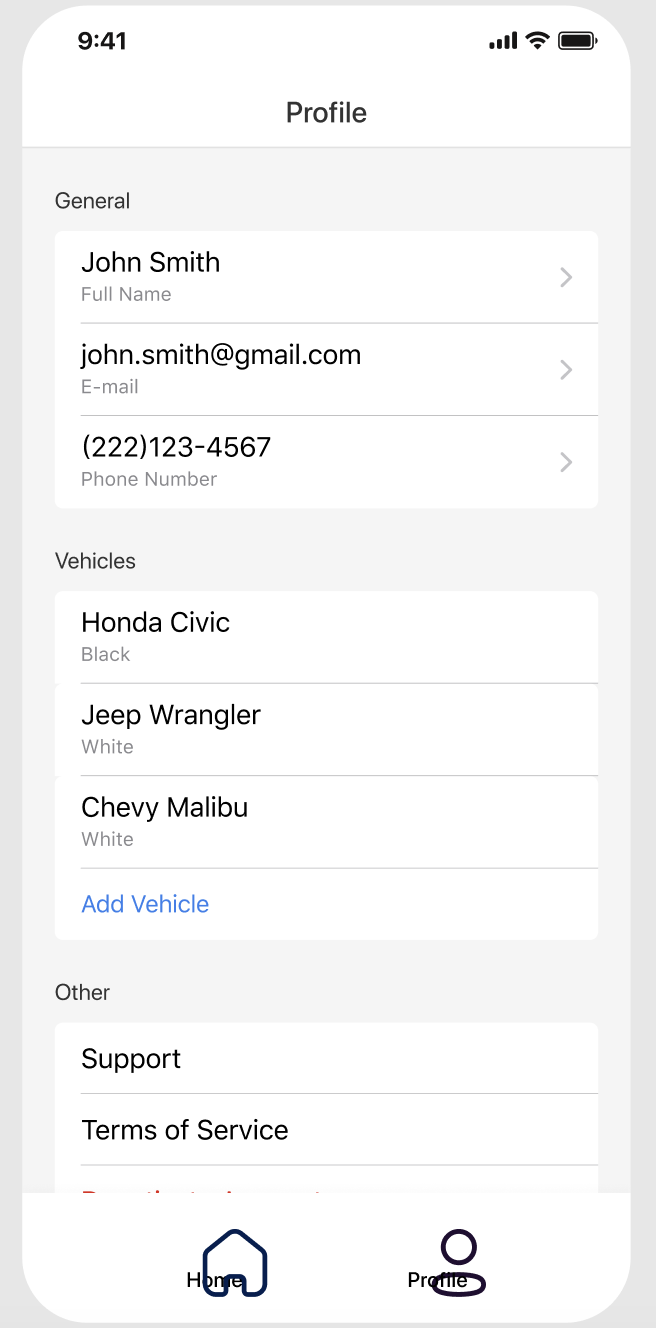I have a SectionList divided into 3 sections:
- General User Info
- User Vehicle Info
- Other Options
The General Info Items need to be TouchableOpacity components so that when a user clicks on them, they route to an update page to update this data.
The Vehicle Info Items are just Text components, but I do need an "Add Vehicle" Button component at the end of this section at all times no matter how many vehicles have been added.
The Other Options Section can all be TouchableOpacity components that redirect to a different page within the application.
How can I render different components within different sections of my SectionList and add certain components to some sections but not others?
This is what I need
SectionList Component
import { StyleSheet, View, Text, SafeAreaView, SectionList } from 'react-native';
import React from 'react';
const SECTIONS = [
{
title: 'General',
data: [
{
key: '1',
content: 'John Smith',
desc: 'Full Name',
},
{
key: '2',
content: '[email protected]',
desc: 'E-mail',
},
{
key: '3',
content: '(222)123-4567',
desc: 'Phone Number'
},
],
},
{
title: 'Vehicles',
data: [
{
key: '4',
content: 'Honda Civic',
desc: 'Black'
},
{
key: '5',
content: 'Jeep Wrangler',
desc: 'White'
},
],
},
{
title: 'Other',
data: [
{
key: '6',
content: 'Support',
desc: ''
},
{
key: '7',
content: 'Terms of Service',
desc: ''
},
{
key: '8',
content: 'Deactivate Account',
desc: ''
},
],
},
];
export default function Profile() {
return (
<SafeAreaView style={styles.container}>
<SectionList
stickySectionHeadersEnabled={false}
sections={SECTIONS}
// keyExtractor={(item, index) => item + index }
renderSectionHeader={({section }) => (
<Text style={styles.header}>{section.title}</Text>
)}
renderItem={({ item, index, section }) => (
<View style={[
styles.item,
index === 0 && styles.itemFirst,
index === section.data.length -1 && styles.itemLast
]}>
<Text style={styles.title}>{item.content}</Text>
<Text style={styles.description}>{item.desc}</Text>
</View>
)}
/>
</SafeAreaView>
);
}
const styles = StyleSheet.create({
container: {
flex: 1,
marginHorizontal: 16,
},
item: {
backgroundColor: '#fff',
borderBottomColor: '#aaa',
borderBottomWidth: 0.2,
paddingVertical: 8,
paddingHorizontal: 20,
marginHorizontal: 10,
},
itemFirst: {
borderTopLeftRadius: 8,
borderTopRightRadius: 8
},
itemLast: {
borderBottomLeftRadius: 8,
borderBottomRightRadius: 8,
borderBottomWidth: 0
},
header: {
fontSize: 14,
marginTop: 20,
marginBottom: 10,
marginHorizontal: 10,
fontWeight: '400',
color: '#333333',
lineHeight: 24,
},
title: {
fontWeight: '400',
fontSize: 17,
lineHeight: 22,
color: '#000000',
marginBottom: 1.85
},
description: {
fontWeight: '400',
fontSize: 12,
lineHeight: 16,
color: 'grey'
},
lineStyle:{
borderWidth: 0.3,
width: "100%",
borderColor:'grey',
marginTop: 7,
},
});





2
Answers
A possible approach would be to introduce a field into each definition in
SECTIONS, indicating thetypeof rendering to use (e.g.extensibleTextList,linkListetc), then switch between components. It would make sense to define a component to do the switching, but the basic idea would be equivalent to:For your "add vehicle" button, you could use a similar technique with
SectionList‘srenderSectionFooterprop.There’s a rough illustration of the basic idea in this sandbox.
You could add a switch statement inside your renderItem callback that returns a different element based on the section you’re in. However, given that:
I would separate the logic for each section and simply map over the items. It’ll keep your SectionList from having too much responsibility, and make each section easier to change later and maintain.
Ideally, each item would have an ID you can use as the key, rather than hard-coding the key into the list. Also, and this is purely personal preference, you could style the containers of the sections rather than each individual item.